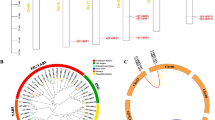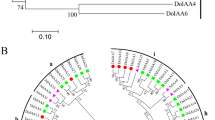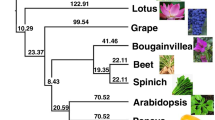Abstract
These YABBY genes are transcription factors (TFs) that play crucial roles in various developmental processes in plants. There is no comprehensive characterization of YABBY genes in a valuable Chinese orchid herb, Dendrobium officinale. In this study, a total of nine YABBY genes were identified in the D. officinale genome. These YABBY genes were divided into four subfamilies: CRC/DL, FIL, INO, and YAB2. Expression pattern analyses showed that eight of the YABBY genes were strongly expressed in reproductive organs (flower buds) but weakly expressed in vegetative organs (roots, leaves, and stems). DoYAB1, DoYAB5, DoDL1, and DoDL3 were abundant in the small flower bud stage, while DoDL2 showed no changes throughout flower development. In addition, DoDL1-3 genes were strongly expressed in the column, tenfold more than in sepals, petals, and the lip. DoYAB1 from the FIL subfamily, DoYAB2 from the YAB2 subfamily, DoYAB3 from the INO subfamily, and DoDL2 and DoDL3 from the CRC/DL subfamily were selected for further analyses. Subcellular localization analysis showed that DoYAB1-3, DoDL2, and DoDL3 were localized in the nucleus. DoYAB2 and DoYAB3 interacted strongly with DoWOX2 and DoWOX4, while DoYAB1 showed a weak interaction with DoWOX4. These results reveal a regulatory network involving YABBY and WOX proteins in D. officinale. Our data provide clues to understanding the role of YABBY genes in the regulation of flower development in this orchid and shed additional light on the function of YABBY genes in plants.







Similar content being viewed by others
Change history
20 June 2023
A Correction to this paper has been published: https://doi.org/10.1007/s00709-023-01875-1
References
Alvarez J, Smyth DR (1999) CRABS CLAW and SPATULA, two Arabidopsis genes that control carpel development in parallel with AGAMOUS. Development 126(11):2377–2386. https://doi.org/10.1242/dev.126.11.2377
Besnard F, Vernoux T, Hamant O (2011) Organogenesis from stem cells in planta: multiple feedback loops integrating molecular and mechanical signals. Cell Mol Life Sci 68(17):2885–2906. https://doi.org/10.1007/s00018-011-0732-4
Boter M, Golz JF, Giménez-Ibañez S, Fernandez-Barbero G, Franco-Zorrilla JM, Solano R (2015) FILAMENTOUS FLOWER is a direct target of JAZ3 and modulates responses to jasmonate. Plant Cell 27(11):3160–3174. https://doi.org/10.1105/tpc.15.00220
Bowman JL (2000) The YABBY gene family and abaxial cell fate. Curr Opin Plant Biol 3(1):17–22. https://doi.org/10.1016/S1369-5266(99)00035-7
Bowman JL, Smyth DR (1999) CRABS CLAW, a gene that regulates carpel and nectary development in Arabidopsis, encodes a novel protein with zinc finger and helix-loop-helix domains. Development 126(11):2387–2396. https://doi.org/10.1242/dev.126.11.2387
Chen QY, Atkinson A, Otsuga D, Christensen T, Reynolds L, Drews GN (1999) The Arabidopsis FILAMENTOUS FLOWER gene is required for flower formation. Development 126(12):2715–2726. https://doi.org/10.1242/dev.126.12.2715
Chen C, Chen H, Zhang Y, Thomas HR, Frank MH, He Y, **a R (2020a) TBtools: an integrative toolkit developed for interactive analyses of big biological data. Mol Plant 13(8):1194–1202. https://doi.org/10.1016/j.molp.2020.06.009
Chen Y-Y, Hsiao Y-Y, Chang S-B, Zhang D, Lan S-R, Liu Z-J, Tsai W-C (2020b) Genome-wide identification of YABBY genes in Orchidaceae and their expression patterns in Phalaenopsis orchid. Genes (Basel) 11(9):955. https://doi.org/10.3390/genes11090955
Chen YY, Hsiao YY, Li CI, Yeh CM, Mitsuda N, Yang HX, Chiu CC, Chang SB, Liu ZJ, Tsai WC (2021) The ancestral duplicated DL/CRC orthologs, PeDL1 and PeDL2, function in orchid reproductive organ innovation. J Exp Bot 72(15):5442–5461. https://doi.org/10.1093/jxb/erab195
Citovsky V, Lee L-Y, Vyas S, Glick E, Chen M-H, Vainstein A, Gafni Y, Gelvin SB, Tzfira T (2006) Subcellular localization of interacting proteins by bimolecular fluorescence complementation in planta. J Mol Biol 362(5):1120–1131. https://doi.org/10.1016/j.jmb.2006.08.017
Costanzo E, Trehin C, Vandenbussche M (2014) The role of WOX genes in flower development. Ann Bot 114(7):1545–1553. https://doi.org/10.1016/10.1093/aob/mcu123
Dai M, Hu Y, Zhao Y, Liu H, Zhou D-X (2007) A WUSCHEL-LIKE HOMEOBOX gene represses a YABBY gene expression required for rice leaf development. Plant Physiol 144(1):380–390. https://doi.org/10.1104/pp.107.095737
di Rienzo V, Imanifard Z, Mascio I, Gasser CS, Skinner DJ, Pierri CL, Marini M, Fanelli V, Sabetta W, Montemurro C, Bellin D (2021) Functional conservation of the grapevine candidate gene INNER NO OUTER for ovule development and seed formation. Hortic Res 8(1):29. https://doi.org/10.1038/s41438-021-00467-5
Eshed Y, Izhaki A, Baum SF, Floyd SK, Bowman JL (2004) Asymmetric leaf development and blade expansion in Arabidopsis are mediated by KANADI and YABBY activities. Development 131(12):2997–3006. https://doi.org/10.1242/dev.01186
Franco-Zorrilla JM, Lopez-Vidriero I, Carrasco JL, Godoy M, Vera P, Solano R (2014) DNA-binding specificities of plant transcription factors and their potential to define target genes. Proc Natl Acad Sci USA 111(6):2367–2372. https://doi.org/10.1073/pnas.1316278111
He C, Zhang J, Liu X, Zeng S, Wu K, Yu Z, Wang X, Teixeira da Silva JA, Lin Z, Duan J (2015) Identification of genes involved in biosynthesis of mannan polysaccharides in Dendrobium officinale by RNA-seq analysis. Plant Mol Biol 88(3):219–231. https://doi.org/10.1007/s11103-015-0316-z
Jang S, Hur J, Kim SJ, Han MJ, Kim SR, An G (2004) Ectopic expression of OsYAB1 causes extra stamens and carpels in rice. Plant Mol Biol 56(1):133–143. https://doi.org/10.1007/s11103-004-2648-y
Katoh K, Standley DM (2013) MAFFT multiple sequence alignment software version 7: improvements in performance and usability. Mol Biol Evol 30(4):772–780. https://doi.org/10.1093/molbev/mst010
Kumar S, Stecher G, Tamura K (2016) MEGA7: molecular evolutionary genetics analysis version 7.0 for bigger datasets. Mol Biol Evol 33(7):1870–1874. https://doi.org/10.1093/molbev/msw054
Kumaran MK, Bowman JL, Sundaresan V (2002) YABBY polarity genes mediate the repression of KNOX homeobox genes in Arabidopsis. Plant Cell 14(11):2761–2770. https://doi.org/10.1105/tpc.004911
Laux T, Mayer KF, Berger J, Jürgens G (1996) The WUSCHEL gene is required for shoot and floral meristem integrity in Arabidopsis. Development 122(1):87–96. https://doi.org/10.1242/dev.122.1.87
Liu S, Li X, Yang H, Qian Q, Lin X (2020) Ectopic expression of BoYAB1, a member of YABBY gene family in Bambusa oldhamii, causes leaf curling and late flowering in Arabidopsis thaliana. J Hortic Sci Biotechnol 95(2):169–174. https://doi.org/10.1080/14620316.2019.1661289
Livak KJ, Schmittgen TD (2001) Analysis of relative gene expression data using real-time quantitative PCR and the 2−ΔΔCT method. Methods 25(4):402–408. https://doi.org/10.1006/meth.2001.1262
Lugassi N, Nakayama N, Bochnik R, Zik M (2010) A novel allele of FILAMENTOUS FLOWER reveals new insights on the link between inflorescence and floral meristem organization and flower morphogenesis. BMC Plant Biol 10.https://doi.org/10.1186/1471-2229-10-131
Meister RJ, Oldenhof H, Bowman JL, Gasser CS (2005) Multiple protein regions contribute to differential activities of YABBY proteins in reproductive development. Plant Physiol 137(2):651–662. https://doi.org/10.1104/pp.104.055368
Mondragon-Palomino M (2013) Perspectives on MADS-box expression during orchid flower evolution and development. Front Plant Sci 4:377. https://doi.org/10.3389/fpls.2013.00377
Murashige T, Skoog F (1962) A revised medium for rapid growth and bioassays with tobacco tissue cultures. Plant Physiol 15(3):473–497. https://doi.org/10.1111/j.1399-3054.1962.tb08052.x
Nagasawa N, Miyoshi M, Sano Y, Satoh H, Hirano H, Sakai H, Nagato Y (2003) SUPERWOMAN1 and DROOPING LEAF genes control floral organ identity in rice. Development 130(4):705–718. https://doi.org/10.1242/dev.00294
Nardmann J, Ji J, Werr W, Scanlon MJ (2004) The maize duplicate genes narrow sheath1 and narrow sheath2 encode a conserved homeobox gene function in a lateral domain of shoot apical meristems. Development 131(12):2827–2839. https://doi.org/10.1242/dev.01164
Nole-Wilson S, Krizek BA (2006) AINTEGUMENTA contributes to organ polarity and regulates growth of lateral organs in combination with YABBY genes. Plant Physiol 141(3):977–987. https://doi.org/10.1104/pp.106.076604
Ohmori Y, Toriba T, Nakamura H, Ichikawa H, Hirano H-Y (2011) Temporal and spatial regulation of DROOPING LEAF gene expression that promotes midrib formation in rice. Plant J 65(1):77–86. https://doi.org/10.1111/j.1365-313X.2010.04404.x
Saitou N, Nei M (1987) The neighbor-joining method - a new method for reconstructing phylogenetic trees. Mol Biol Evol 4(4):406–425. https://doi.org/10.1093/oxfordjournals.molbev.a040454
Sawa S, Ito T, Shimura Y, Okada K (1999a) FILAMENTOUS FLOWER controls the formation and development of Arabidopsis inflorescences and floral meristems. Plant Cell 11(1):69–86. https://doi.org/10.1105/tpc.11.1.69
Sawa S, Watanabe K, Goto K, Kanaya E, Morita EH, Okada K (1999b) FILAMENTOUS FLOWER, a meristem and organ identity gene of Arabidopsis, encodes a protein with a zinc finger and HMG-related domains. Genes Dev 13(9):1079–1088. https://doi.org/10.1101/gad.13.9.1079
Siegfried KR, Eshed Y, Baum SF, Otsuga D, Drews GN, Bowman JL (1999) Members of the YABBY gene family specify abaxial cell fate in Arabidopsis. Development 126(18):4117–4128. https://doi.org/10.1242/dev.126.18.4117
Sun W, Huang W, Li Z, Lv H, Huang H, Wang Y (2013) Characterization of a crabs claw gene in basal eudicot species Epimedium sagittatum (Berberidaceae). Int J Mol Sci 14(1):1119–1131. https://doi.org/10.3390/ijms14011119
Tanaka W, Toriba T, Ohmori Y, Yoshida A, Kawai A, Mayama-Tsuchida T, Ichikawa H, Mitsuda N, Ohme-Takagi M, Hirano H-Y (2012) The YABBY gene TONGARI-BOUSHI1 is involved in lateral organ development and maintenance of meristem organization in the rice spikelet. Plant Cell 24(1):80–95. https://doi.org/10.1105/tpc.111.094797
Toriba T, Harada K, Takamura A, Nakamura H, Ichikawa H, Suzaki T, Hirano H-Y (2007) Molecular characterization the YABBY gene family in Oryza sativa and expression analysis of OsYABBY1. Mol Genet Genomics 277(5):457–468. https://doi.org/10.1007/s00438-006-0202-0
van der Graaff E, Laux T, Rensing SA (2009) The WUS homeobox-containing (WOX) protein family. Genome Biol 10(12):248. https://doi.org/10.1186/gb-2009-10-12-248
Vandenbussche M, Horstman A, Zethof J, Koes R, Rijpkema AS, Gerats T (2009) Differential recruitment of WOX transcription factors for lateral development and organ fusion in Petunia and Arabidopsis. Plant Cell 21(8):2269–2283. https://doi.org/10.1105/tpc.109.065862
Wang A, Tang J, Li D, Chen C, Zhao X, Zhu L (2009) Isolation and functional analysis of LiYAB1, a YABBY family gene, from lily (Lilium longiflorum). J Plant Physiol 166(9):988–995. https://doi.org/10.1016/j.jplph.2008.11.011
Wang Q, Reddy VA, Panicker D, Mao H-Z, Kumar N, Rajan C, Venkatesh PN, Chua N-H, Sarojam R (2016) Metabolic engineering of terpene biosynthesis in plants using a trichome-specific transcription factor MsYABBY5 from spearmint (Mentha spicata). Plant Biotechnol J 14(7):1619–1632. https://doi.org/10.1111/pbi.12525
Yamada T, Yokota SY, Hirayama Y, Imaichi R, Kato M, Gasser CS (2011) Ancestral expression patterns and evolutionary diversification of YABBY genes in angiosperms. Plant J 67(1):26–36. https://doi.org/10.1111/j.1365-313X.2011.04570.x
Yamaguchi T, Nagasawa N, Kawasaki S, Matsuoka M, Nagato Y, Hirano HY (2004) The YABBY gene DROOPING LEAF regulates carpel specification and midrib development in Oryza sativa. Plant Cell 16(2):500–509. https://doi.org/10.1105/tpc.018044
Yang H, Shi G, Li X, Hu D, Cui Y, Hou J, Yu D, Huang F (2019) Overexpression of a soybean YABBY gene, GmFILa, causes leaf curling in Arabidopsis thaliana. BMC Plant Biol 19:234. https://doi.org/10.1186/s12870-019-1810-2
Yoo S-D, Cho Y-H, Sheen J (2007) Arabidopsis mesophyll protoplasts: a versatile cell system for transient gene expression analysis. Nat Protoc 2(7):1565–1572. https://doi.org/10.1038/nprot.2007.199
Zhang T, Li C, Li D, Liu Y, Yang X (2020) Roles of YABBY transcription factors in the modulation of morphogenesis, development, and phytohormone and stress responses in plants. J Plant Res 133(6):751–763. https://doi.org/10.1007/s10265-020-01227-7
Zhao S-P, Lu D, Yu T-F, Ji Y-J, Zheng WJ, Zhang S-X, Chai S-C, Chen Z-Y, Cui X-Y (2017) Genome-wide analysis of the YABBY family in soybean and functional identification of GmYABBY10 involvement in high salt and drought stresses. Plant Physiol Biochem 119:132–146. https://doi.org/10.1016/j.plaphy.2017.08.026
Funding
This work was supported by the National Natural Science Foundation of China (grant number: 32071819), the Natural Science Foundation of Guangdong Province Projects (grant number: 2021A1515012170), and the Guangdong Forestry Science and Technology Innovation Program (2018KJCX032).
Author information
Authors and Affiliations
Contributions
CH conceived and designed the experiments. DZ performed the experiments. CH and DZ co-drafted the initial manuscript. DZ, CS, and GD participated in sample collection and data analyses. JATS provided scientific guidance and advice. JATS and DZ co-revised the manuscript. JD provided suggestions for the manuscript. All authors have read and agreed to the published version of the manuscript.
Corresponding author
Ethics declarations
Competing interests
The authors declare no competing interests.
Additional information
Handling Editor: Pengguo **a
Publisher's note
Springer Nature remains neutral with regard to jurisdictional claims in published maps and institutional affiliations.
Supplementary Information
Below is the link to the electronic supplementary material.
Rights and permissions
Springer Nature or its licensor (e.g. a society or other partner) holds exclusive rights to this article under a publishing agreement with the author(s) or other rightsholder(s); author self-archiving of the accepted manuscript version of this article is solely governed by the terms of such publishing agreement and applicable law.
About this article
Cite this article
Zeng, D., Si, C., Teixeira da Silva, J.A. et al. Characterization of YABBY genes in Dendrobium officinale reveals their potential roles in flower development. Protoplasma 260, 483–495 (2023). https://doi.org/10.1007/s00709-022-01790-x
Received:
Accepted:
Published:
Issue Date:
DOI: https://doi.org/10.1007/s00709-022-01790-x




